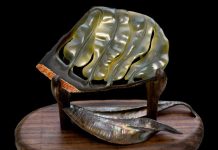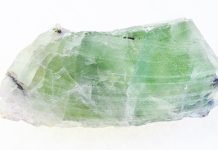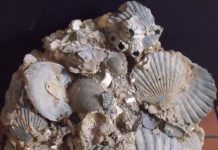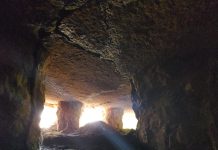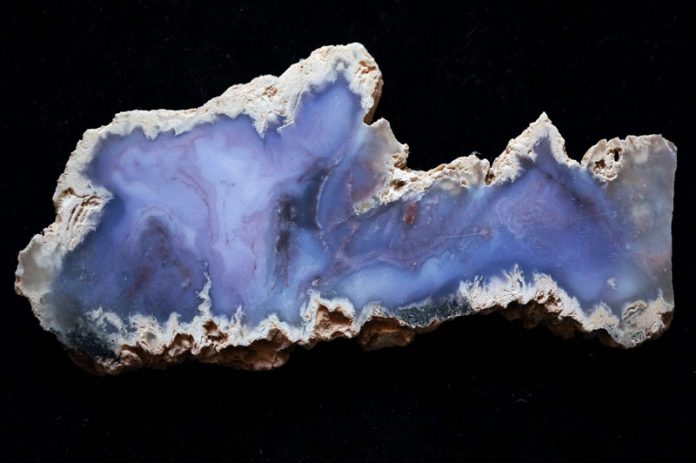
Purple rocks and crystals were in the spotlight with viva magenta as the Pantone Color of the Year for 2023. Regardless of Pantone fame, the violet-to-magenta is always popular with collectors and lapadarists.
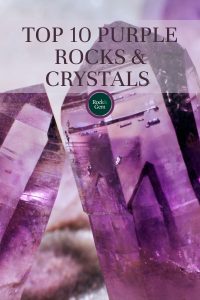
Viva magenta is a deeper shade of hot pink, a balance between warm and cool, with saturated reddish and purple undertones. Hues range from violet to mauve, purple, indigo, lilac, plum, lavender, crimson, maroon, burgundy, fuchsia and magenta. The varying amounts of blue and red color pigments based on the mineral’s chemical compositions, tip the balance slightly from one color hue to the next.
This enchanting palette includes many favorite lapidary materials. Among them are amethyst, purple chalcedony, charoite, sugilite, lavender jade, tiffany stone, tanzanite, kunzite, purple sapphires, fluorite, rubellite tourmaline, and red garnets, including pyrope, rhodolite, almandine, and anthill garnets. Transparent gemstones are commonly faceted, while the opaque materials are more often cut as cabochons, free-forms, carvings, beads, eggs, and spheres.
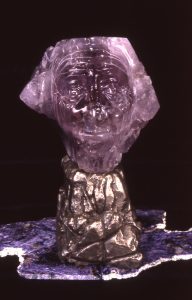
1. Amethyst & Purple Chalcedony
Amethyst is a prominent crystalline quartz variety, with crystals that exhibit well-defined terminations. Amethyst has been a favorite lapidary material since ancient times. he chalcedony group is a crypto-crystalline variety of quartz that has crystals too small to be seen under the microscope. Purple chalcedonies are attractive for their color uniformity, but fine white lacey bands and fortification patterns may also be present, as in Holley blue chalcedony. This material is found near Holley, just four miles southwest of the town of Sweet Home in western Oregon.
Highly translucent, gel-like material is held in high esteem by carvers for its distinct color and uniformity, but sand-like rhyolite inclusions may make the material more attention-grabbing.
Purple botryoidal chalcedony with a globular external mineral habit or grape-like structure occurs in a couple of different locations. A pastel purple variety is found in the Bradshaw Mountains near Prescott, Arizona. Another one, deeper in color, also known as grape agate, has been recently discovered at Manakarra Beach in Indonesia and has been a big hit on the market among lapidaries, designers, and collectors.
Burro Creek agate (also a chalcedony) occurs south of Burro Creek in Mohave County, Arizona, a favorite rock-hounding location. Lighter-colored material is referred to as pastelite. Burro Creek agate exhibits a soft shade of purple; under shortwave UV light, it fluoresces green and white.
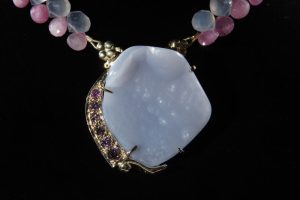
Photo by Helen Serras-Herman
2. Violet, Purple to Plum Sapphires
Sapphires come from world-famous locations, including Burma and Africa. Sapphires mined in Montana are among the most beautiful and valuable transparent gemstones in North America. They come in every color of the rainbow, colorless too, including shades from hot pink to purple. All colors beyond blue are considered fancy-color sapphires, except for the red ones, which are rubies. Transparent sapphires are usually faceted, but some may also be cabbed. They are hard and durable, and the perfect match for any jewelry design project.
Some reddish-purple opaque sapphires when cut as cabochons exhibit the rare phenomenon of asterism. Plum-color star sapphires come from India, but are also mined in North Carolina. The mines are spread around Cowee Valley, in Macon County, near the town of Franklin. The mines produce corundum sapphires and rubies, mostly opaque, but many show perfect hexagonal crystal shapes. Most mines are open to the public with covered flume lines allowing people to enjoy gem mining.
A distinct opaque variety of purple sapphire is the rare watermelon sapphire from Pakistan. This watermelon sapphire, although similar in look to the bright red ruby in green zoisite from Tanzania, has a deep violet-purple sapphire core surrounded by green muscovite mica skin.
It was identified as such after examination and analysis performed by the GIA West Coast Gem Trade Laboratory (Gems & Gemology, Summer 1991). The material is mined near West Village, Timargara, Dir District, Malakand Agency, Northwest Frontier Province, in Pakistan.
3. Kunzite
Kunzite is the lilac to violet variety of the mineral spodumene. It is a LiAl [Si 2O 6] lithium aluminum silicate. Kunzite occurs in Brazil, Afghanistan, and Pakistan, and in the famous pegmatite mines of San Diego County, in southern California.
Kunzite’s hardness is 6.5 to 7 Mohs. With two perfect cleavage directions, and pleochroism best visible down the length of the crystal, kunzite may present challenges in cutting that require careful orientation by the lapidary.
4. Lavender Jadeite
Jadeite occurs in all colors in Burma and Guatemala. Pastel-colored lavender jadeite from Guatemala is mined in the Montagua River Valley. This lavender jadeite has a granular physical appearance with a greasy luster, but it takes an easy and good polish.
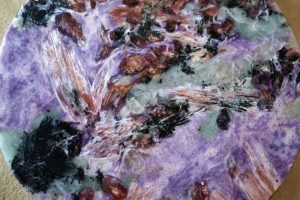
Photo by Helen Serras-Herman
5. Charoite
Charoite is named after the place of discovery, the Chara River in the Sakha Republic of Eastern Siberia, in Russia. It is a rare silicate mineral with the chemical formula K(Ca, Na) 2Si 4O 10(OH,F).
Beautiful swirling patterns of various shades are attributed to the coexistence of manganese and iron (Mn3+ and Fe 3+). White, fibrous, asbestos-charoite bands display silky chatoyancy — a cat’s eye effect—and pearly luster.
Charoite occurs together with other minerals, including canasite and carbonates, quartz, pale green microcline feldspar, dark green to black star-shaped sprays of aegirine-augite, sphene, and raspberry red fedorite. Also, golden chatoyant blades of tinaksite may create striking chrysanthemum patterns. Flower charoite exhibits together many of these inclusions, and has a beautiful, visually ornate look.
Charoite’s hardness is Mohs 5 to 6, but its fibrous texture can be challenging for the lapidary. Correct orientation (parallel to the banding) and slow cutting are paramount to avoid flaking, shredding, or splintering. Cut gemstones take a great polish, best by using diamond all the way.
6. Tanzanite
Tanzanite is the rare blue-violet variety of the mineral zoisite, named after Tanzania where the gemstone was first discovered at the hills of Merelani in 1967. The trade name, tanzanite, was first introduced by Tiffany & Company. Tanzanite has a chemical composition of Ca2Al 3(SiO 4) 3(OH) and Mohs hardness 6 to 7.
Tanzanite crystals exhibit pleochroism (or trichroism) with three distinct colors — blue, violet, and burgundy — in three crystal directions. This optical property is at times challenging for lapidaries. Cutting, especially faceting, may depend on the desired color or most crystal weight retention. Brilliant, deeply saturated blue-violet color tanzanite gemstones often achieve their color by heat treatment, occasionally by nature but mostly in the lab. Tanzanite is also fashioned as faceted beads.
7. Tiffany Stone
Tiffany Stone is the trade name for Bertrandite — the violet-and-cream-toned fluorescent beryllium hydrous silicate mined at the Topaz and Spors Mountains in Juab County, Utah. Tiffany stone is a complex mineral canvas with purple fluorite, white to pale yellow opal, massive violet bertrandite, and chalcedony. Splashes of dark pink and red colors and drusy quartz pockets add to the rarity and value.
8. Sugilite
Sugilite is a pink to purple cyclosilicate mineral with the complex chemical formula KNa 2Fe 3+ 2(Li 3Si 12). It is commonly found in a massive form. It was first found in Japan, but its best-known mining location is the Wessels Mine, in Northern Cape Province in South Africa.
Sugilite’s hardness is Mohs 5.5 to 6.5. Its color ranges from lavender to purple, lavender-pink, and dark purple. Material with bright purple color and high translucency (gel sugilite) is considered the rarest. Occasionally, sugilite occurs with blue veins of the mineral richterite.
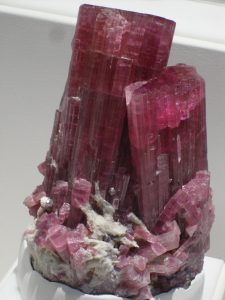
Photo by Helen Serras-Herman
9. Rubellite Tourmaline
Tourmaline is a cyclosilicate mineral group, with members occurring in all colors of the rainbow, colorless and black too. Red tourmaline, mostly known as rubellite, ranges in color from bright cherry red to dark crimson, or purplish red. Tourmaline crystals were first brought into Europe from Sri Lanka (Ceylon) in the early 17th century.
A number of tourmalines are named after the original location of discovery. Other tourmalines are known by their color prefix. Rubellites come from Brazil and Afghanistan, and the famous Pala mines in San Diego County, California. Bi-color pink and green tourmalines with colors side-by-side, and watermelon tourmalines with an outer green color and inner pink-red color, are favorites. Tourmaline usually occurs in long hexagonal crystals often referred to as pencils. Tourmaline is slightly harder than quartz, coming in at 7.5 Mohs.
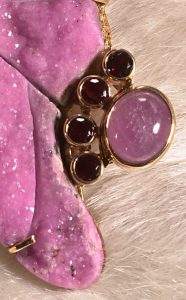
Photo by Helen Serras-Herman
10. Red Garnets
A garnet is a large group of silicate minerals. The various garnet species occur in many colors, including green (tsavorite and grossular). Red garnets fall in the pyrope-almandine-spessartine (pyralspite) series. They include the blood-red colored pyrope garnet, the dark crimson-red almandine garnet, and the violet-red rhodolite garnet, which are often found together with rubies and sapphires at the mines in Macon County, North Carolina.
In addition, deep burgundy-colored chromium pyrope anthill garnets are found in Apache County, Arizona, mined only by the Native American Navajo and Hopi tribes. They are called “ant hill” garnets because they are brought up from the ground to the surface by ants.
Garnets often occur in perfect rhombic dodecahedrons or cubic crystals, with hardness Mohs 6.5-7.5. Many garnets are free of inclusions and perfect candidates for faceting.
This story about purple rocks and crystals previously appeared in Rock & Gem magazine. Click here to subscribe! Story by Helen Seras-Herman.


